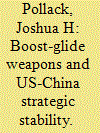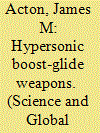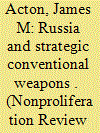|
|
|
Sort Order |
|
|
|
Items / Page
|
|
|
|
|
|
|
| Srl | Item |
| 1 |
ID:
143302


|
|
|
|
|
| Summary/Abstract |
The United States and China are testing boost-glide weapons, long-range strike systems capable of flying at Mach 5 or faster through the upper atmosphere. For the United States, these systems would provide a conventional prompt global strike capability, which, together with US ballistic missile defense programs, Chinese experts regard as a threat to China's ability to conduct nuclear retaliation. This perception is encouraging the Chinese military to modify its nuclear posture in ways that tend to create greater risks for both sides. If China's own boost-glide systems are meant to carry nuclear payloads only, their deployment would not fundamentally alter the current situation between the two states. However, if they were conventionally armed or dual-purpose, or if the United States could not determine the payloads they carried, the deployment of Chinese boost-glide systems could compound problems of strategic stability created by the introduction of ballistic missile defense, antisatellite, and antiship ballistic missile capabilities. If the technical hurdles can be overcome, it may be difficult for the two sides to refrain from these deployments in the absence of strong mutual trust or an established arms-control relationship. New confidence-building measures and expanded mutual transparency are warranted to avoid creating new dangers.
|
|
|
|
|
|
|
|
|
|
|
|
|
|
|
|
| 2 |
ID:
142266


|
|
|
|
|
| Summary/Abstract |
The United States, Russia and China are developing hypersonic boost-glide vehicles. A simple model of their trajectory is developed by assuming that the vehicle does not oscillate during the transition to equilibrium gliding. This model is used to analyze U.S. Department of Defense data on test flights for the Hypersonic Technology Vehicle-2. This glider's lift-to-drag ratio—a key performance parameter—is estimated to be 2.6. The model is also used to calculate the tactical warning time that a boost-glide attack would afford an adversary. Other aspects of boost-glide weapons’ military effectiveness are explored. Approximate calculations suggest that, compared to existing non-nuclear weapons, boost-glide weapons could penetrate more deeply but would be less effective at destroying silos. The distance at which a boost-glide weapon armed with a particle dispersion warhead could destroy a mobile missile is also calculated; it is expected to be significantly larger than for an explosive warhead.
|
|
|
|
|
|
|
|
|
|
|
|
|
|
|
|
| 3 |
ID:
143301


|
|
|
|
|
| Summary/Abstract |
Russian political leaders and military strategists are growing increasingly concerned about “strategic conventional weapons”—a broad category that appears to include all non-nuclear, high-precision, standoff weapons—and about long-range, hypersonic weapons, in particular. These concerns are complex and multifaceted (and, in some cases, contradictory), but chief among them are the beliefs that strategic conventional weapons could prove decisive in a major conflict and that Russia is lagging behind in their development. US programs to develop and acquire such weapons—namely, the Conventional Prompt Global Strike program—are of great concern to Russian strategists, who argue both that the United States seeks such weapons for potential use against Russia—its nuclear forces, in particular—and because strategic conventional weapons are more “usable” than nuclear weapons. Asymmetric responses by Russia include increased reliance on tactical nuclear weapons, efforts to enhance the survivability of its nuclear forces, and investments in air and missile defenses. There is also strong—but not completely conclusive evidence—that Russia is responding symmetrically by attempting to develop a long-range, conventionally armed boost-glide weapon.
|
|
|
|
|
|
|
|
|
|
|
|
|
|
|
|
|
|
|
|
|